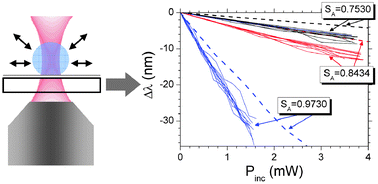Large spectral tuning of a water–glycerol microdroplet standing on a superhydrophobic surface by local heating with a focused infrared laser is studied both experimentally by optical spectroscopy and computationally using a lumped system formulation of the mass and heat transfer between the microdroplet and the chamber. The effects of optical scattering force, chamber humidity, size of microdroplet and laser power on the tuning mechanism are examined. The reversibility of the tuning mechanism is also studied. In spite of its negligibly small volatility compared to that of water, irreversibility is found to be mainly caused by evaporation of glycerol. It is also found that reversibility increases dramatically with the relative water and glycerol humidities, and spectral tuning can be made almost fully reversible when the chamber is saturated with glycerol vapor and the relative water humidity approaches unity. Some hysteresis effects are observed, especially in large microdroplets, and this behavior is attributed to the whispering-gallery mode resonances in laser absorption. The time response of the tuning mechanism is also analyzed both experimentally and computationally. The technique presented can find applications in optical communication systems, and can be used in fundamental studies in cavity quantum electrodynamics and in characterizing liquid aerosols on a surface.

You have access to this article
 Please wait while we load your content...
Something went wrong. Try again?
Please wait while we load your content...
Something went wrong. Try again?


 Please wait while we load your content...
Please wait while we load your content...